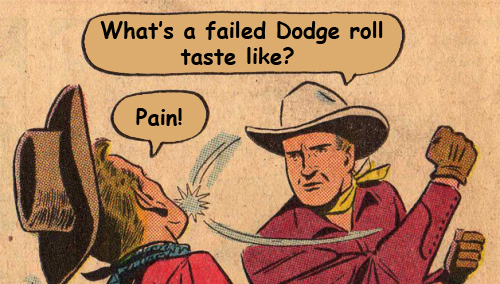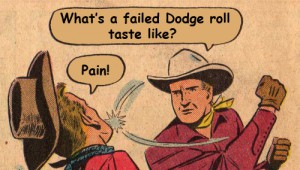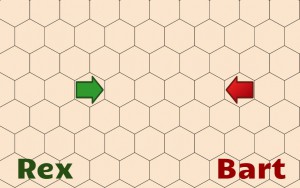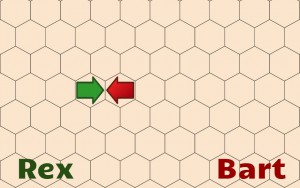
Welcome back, GURPers (GURPies? No…), to another post for anyone “New to GURPS.” This week, now that we’ve learned all about skills and how to use them, we look at one specific skills subset — combat, a bit of the old ultra-violence! Though, it won’t be too ultra. I mean, this is the first combat post — we’re still in shallow waters. But I hope Rex has been keeping up his insurance premiums, ’cause things could get ugly as we take him step-by-step through a basic melee combat.
Hopefully you’ve already read pp. 24-31 of GURPS Lite — it outlines the entire flow of combat (which is identical to what’s in the non-Lite GURPS Basic Set, just with fewer options… learning GURPS Lite is learning “real” GURPS!)
While the game is chugging along in “real time,” you can say things to the GM like, “Rex spends the day fishing and hunting, then camps out on the prairie a couple miles from town. In the morning, he goes to visit his friends at the Bar-L Ranch.” You can describe an hour, a day, a week.
But when combat erupts — when events unfolding in the story have a very real possibility of injuring or even killing someone — time nearly freezes, ticking along second-by-second. During each of these one-second turns, every combatant involved in the fight chooses a particular maneuver (pp. 25-26). Once everyone has acted, the fastest character then gets his second turn, and so on.
If you want to attack someone/something, you…
- ATTACK by choosing and resolving a maneuver, then rolling against the applicable skill. If you fail, you miss; if you succeed, you might hit! You’ve scored well enough to hit a target that is standing there, motionless, not defending itself. But this is almost never the case. Usually, your target has a chance to…
- DEFEND by rolling against his Active Defense score (Dodge, Parry, or Block). If he succeeds, you miss; if he fails, then your blow has successfully landed. Booyah! You now roll for…
- DAMAGE by rolling the listed damage of the attack that hit and modifying for damage type. (In future examples we’ll get to things like Damage Reduction [DR, p. 29] and Hit Locations [Basic Set], but not now).
It definitely sounds way more complicated all typed out than it actually is in play. The attacker attacks, the defender defends, and if a hit was scored, damage is rolled — that’s it.
Checking in on our dear friend Rex, we find that, after a long night of carousing, he is heading back to his hotel room for some much-needed shuteye. A low-down, no-good sidewinder named Big Bad Bart decides that Rex’s money and valuables would make an excellent addition to his own. He attempts to sneak up on Rex, but the GM rolls poorly and fails a Quick Contest of Bart’s Stealth vs. Rex’s Perception. Rex, inconveniently unarmed but not surprised, turns around to see Bart approaching from 5 yards away with a club in his hand.
As p. 25 explains, the faster character goes first. Rex has a Basic Speed of 5.5 and a DX of 12. Bart also has a Basic Speed of 5.5, but his DX is only 11, so Rex goes first.
(I won’t really be getting into when and why it’s better to choose certain maneuvers over others here in the basic examples, beyond maybe a line or two — I’m trying to explain the mechanics of how they work at the moment, not what the optimal strategies are for various combat situations).
Rex’s first turn
Rex, HP: 11 Bart, HP: 10
MANEUVER: All-Out Defense (Increased Defense)
Because Rex’s pistol is in the shop for a tune-up, he actually can’t reach Bart with an attack this turn (don’t worry, he’ll have it back in time for Your First Ranged Combat). Instead of attacking, he chooses the maneuver All-Out Defense (Increased Defense) to get a +2 bonus to defend this turn.
Player: “I turn to face the oncoming thief, and shout ‘Come on, ya varmint! If you want what’s mine, yer gonna have to work for it!”
Bart’s first turn
Rex, HP: 11 Bart, HP: 10
ATTACK: Move and Attack.
Bart does have a weapon, a club, but he has to be in a hex next to Rex to use it. He chooses the maneuver Move and Attack, allowing him to run his full Move score in yards (hexes) and still get to attack (at a penalty). His Move score is 5, so he closes the distance and takes a swing (he only needs to move 4 hexes). His Club skill is 12, and the Move and Attack maneuver gives him a penalty of -4, so he is rolling against a target number of 8. But the GM rolls a 14, so Bart’s attack fails.
GM: “The robber rushes towards you and takes a wild swing, but misses by a good bit.”
All combatants have acted, drawing the first second of combat to a close.
That wasn’t too bad, right? The fastest character chooses a maneuver, resolves it, then the next fastest does the same, then the next, and when everyone has acted, you go back to the top of the order and do it all over again.
Rex’s second turn
Rex, HP: 11 Bart, HP: 10
ATTACK: Attack
Now that Bart is close enough, Rex can try to lay some smack down on him. Rex does have a knife on his belt, but he’s not that great at fighting with it. He chooses the Attack maneuver to try and punch Bart. His skill at punching is 12 (on the back of his character sheet, from Brawling) and he rolls a 10, succeeding by 2 — he might give Bart a good smack.
DEFEND: Bart’s Dodge is 9, and his Parry with the club is 8, so he attempts to Dodge the incoming punch. Unfortunately for him, the GM rolls a 10 against his target number of 9, missing by 1. Rex’s punch lands!
DAMAGE: The damage for Rex’s punch is listed as “1d-2 cr,” so he rolls a single d6 and gets a 5. Subtracting 2 gives a final damage result of 3. (If Bart was wearing any kind of armor, its DR would be subtracted from the damage at this point. Also, the “cr” listed for Rex’s punch is the damage type [p. 29], and stands for “crushing,” which has no additional modifier. All of these things will be explored in future posts, I just wanted to give a heads up now that they exist). Applying Rex’s damage of 3 lowers Bart’s Hit Points from 10 to 7.
GM: “Rex socks Bart right across the jaw, wounding him but not putting him out of the fight. A thin trickle of blood runs from the corner of Bart’s mouth.” (GURPS does have comprehensive rules for targeting specific hit locations, but they are not addressed in Lite… saying the blow landed on Bart’s jaw is just for flavor).
Bart’s second turn
Rex, HP: 11 Bart, HP: 7
ATTACK: Attack
One very important thing to remember is Shock (p. 30)… because Bart was wounded, he is temporarily at -3 (the amount of damage he received) to all skill use this turn, including combat skills (but not active defenses). Normally, this would mean it might be a good time for caution, but Bart isn’t the brightest man, and he is pretty sure he can end this fight with one solid smack. He chooses the Attack maneuver to try and hit Rex with his club. Applying the -3 shock penalty to his Club skill of 12 gives a target number of 9, and the GM rolls… an 8! Even after having his bell rung, Bart might still hit Rex.
DEFEND: Rex’s Dodge is 9, and his Parry is 10, but… parrying a weapon bare-handed gives a penalty of -3 (p. 28), so in this case his Parry would only be 7. He chooses to Dodge instead, and rolls a 14 — failure! Bart’s club successfully connects.
DAMAGE: The damage for Bart’s club is 1d+1, but luckily for Rex he rolls a 1, so total damage is only 2 points. Applying Bart’s damage of 2 lowers Rex’s Hit Points from 11 to 9, and gives a temporary shock penalty of -2.
GM: “Bart’s club arcs through the air towards Rex and lands a glancing blow across his temple. That’s gonna leave a mark.”
All characters have acted. The second… um, second ends.
Rex’s third turn
Rex, HP: 9 Bart, HP: 7
ATTACK: All-Out Attack (Determined)
Rex, being a reckless young buck, lets his anger get the best of him. He forfeits all defenses for the rest of this turn and chooses the All-Out Attack (Determined) maneuver to get a +4 bonus to hit, and tries to kick Bart. His skill at kicking is 10 (again, on back of sheet — it’s Brawling-2, because kicking is harder than punching, but does more damage). The All-Out Attack gives him a +4, and his shock penalty gives a -2, so his effective skill is 12 (that is, 10+4-2). He rolls 3d6 and gets an 11, scoring a possible hit on Bart! (He would have missed with this kick if it weren’t for the +4 maneuver bonus).
DEFEND: Bart again rolls against his Dodge of 9, and gets a 13. Ooh, bad news for him… Rex’s kick lands.
DAMAGE: The damage for Rex’s kick is “1d cr.” He rolls a single d6 and gets a 4, further lowering Bart’s Hit Points from 7 to 3.
GM: “Reflexively lashing out after being clubbed, Rex plants a solid kick to Bart’s belly, taking the wind out of his sails.”
Bart’s third turn
Rex, HP: 9 Bart, HP: 3
MANEUVER: none
Now, because Bart has been reduced to fewer than 1/3 of his starting HP, he’s in pretty ragged shape (p. 29). His move of 5 becomes a 3, and his Dodge of 9 becomes a 5 (though his Parry remains at 8). This fight is not going the way he anticipated at all! He could choose to keep fighting and attack again — Rex has no defense at all, having just done an All-Out Attack — but on the other hand, he was just looking for some easy money and instead found a beatdown. This money? Not so easy.
The GM could handle this a number of ways. Bart might try to run away (though Rex could easily catch him if he wants to, since Bart is moving so much slower now). Depending on what skills he has, he might try to Intimidate Rex into surrendering, or Fast-Talk him into believing this whole thing was just some kind of misunderstanding, etc. But unless Bart is akin to something like a berserker or kamikaze, he probably won’t continue risking his life against such an apparently-scrappy cowboy for just a few bucks.
“Combat time” ends, and the story continues as usual.
Congratulations! You, and Rex, have survived your first GURPS combat. Give a roar, c’mon!
Hopefully, it was all straightforward and clear enough: attack, defend, damage… repeat (which isn’t to say it’s boring, far from it — but narrative description is a totally different topic than the rules mechanics). If you followed this along and it made sense, we can build on it in weeks to come. If anything was confusing or you have questions, feel free to leave a comment below or contact me some other way. The official GURPS forums are also super active and extremely helpful.
Finally, I have quite a few other combat examples elsewhere on the site, but be aware that they’re not specifically geared towards beginners, and most include quite a few options we haven’t talked about yet.
See ya next time!



Might want to point out that the Turn 1, Turn 2, etc. count is, mechanically, meaningless. There is no “Turn 1” that ends once everyone has acted once. Anything that has an effect “for the rest of the turn” or “until the next turn” is actually “until _your_ next turn.”
I’m sure you know that, but it’s a point that new players and GMs sometimes miss.
Hiya, MWS. I’m always torn by that, since it just seems clearer to use “Turn 1” etc. when writing second-by-second examples, but you’re right — might as well not start bad habits that can be avoided. Updated — thanks!
I am trying to understand combat and initiative. If someone has basic speed 6 and encumbrance move 4 does he start first in combat from someone with basic speed 5 and move 5?
Hiya, Eli! Basic Speed is the only thing that affects a character’s turn order; Move never does.
Basic Speed measures your reaction time, your reflexes, and is never changed by encumbrance. Move can change depending on how much weight you’re carrying, whether you’re badly injured, etc… but the *only* thing it measures is how many hexes/yards you can move in a one-second turn. That’s it.
So, in your example, the character with Basic Speed 6/Move 4 absolutely acts before the character with Basic Speed 5/Move 5.
Put another way, Basic Speed measures when you can act in the turn order; Move measures how many hexes you can move whenever it is you get to act.
Hope that helps!
Thank you, i was a little confused with initiative your answer helped me understand it.